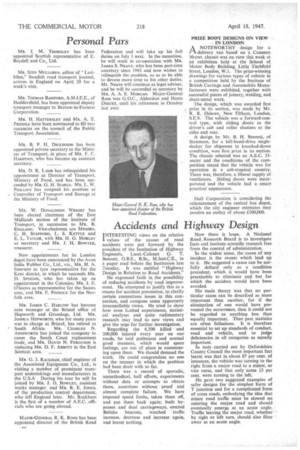Accidents and
Page 30

If you've noticed an error in this article please click here to report it so we can fix it.
Highway Design I NTERESTING views on the relative values of the causes of road accidents were put forward by the president of the Institution of Highway Engineers, Lieut.-Colonel G. T. Bennett, 0.8.E., B.Sc., M,Inst.C.E., in a paper read before the Institution last Tuesday. It was entitled "Highway Design in Relation to Road Accidents." He expressed faith in the possibility of reducing accidents by road improvement. He attempted to justify this as a means for accident prevention, to clarify certain contentious issues in this connection, and compose some apparently irreconcilable views. He tried to show how even limited experiments, statistical analyses and quite rudimentary research may lead to new views and give the urge for further investigation: Regarding the 6,500 killed and 200,000 injured every year on our roads, he said politeness and normal good manners, which would spare feelings, are out of place in commenting upon them. We should demand the truth. He could congratulate no one on the manner in which the problem had been dealt with so far.
There was a record of sporadic, unmethodical, half efforts, experiments without data or attempts to obtain them, assertions without proof and almost complete failure. We have imposed speed limits, taken them off, and put them back again; built bypasses and dual carriageways, erected Belisha beacons, watched traffic increase, decrease and increase again, and learnt nothing. Now there is hope. A National Road Research Board is to investigate facts and institute scientific research free from the control of administration.
In the widest sense, the cause of any incident is the events which lead up to it. He suggested a cause can be use fully defined only as a condition precedent, which it would have been practicable to eliminate and but for which the accident would have been avoided.
His main theory was that no particular cause can be described as more important than another, for if the elimination of one would have prevented the occurrence, then it could not be regarded as anything less than equally important. Thus past statistics are often fallacious. It is therefore essential to set up standards of conduct, road and vehicle, and to judge deficiencies in all categories as equally important.
In tests carried out by Oxfordshire County Council the most important fact learnt was that in about R7 per cent. of instances, the vehicle was turning to the right from a major road to a minor, or vice versa, and that only some 13 per cent. were turning to the left.
He gave two suggested examples of safer designs for the simplest form of T junction and for a complicated form
of cross roads, embodying the idea that minor road traffic must be slowed on
entering the major road and should eventually emerge at an acute angle. Traffic leaving the major road, whether by right or left turn, should also filter away at an acute angle.




















































































